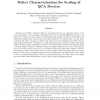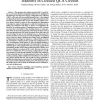20 search results - page 4 / 4 » Logic and Fault Simulation by Cellular Automata |
DFT
2005
IEEE
13 years 11 months ago
2005
IEEE
This paper analyzes the deposition defects in devices and circuits made of Quantum-dot Cellular Automata (QCA) for molecular implementation. Differently from metal-based QCA, in ...
MJ
2006
13 years 6 months ago
2006
This paper proposes a SPICE model development methodology for quantum-dot cellular automata (QCA) cells and presents a SPICE model for QCA cells. The model is validated by simulat...
DFT
2004
IEEE
13 years 9 months ago
2004
IEEE
Quantum dot Cellular Automata (QCA) is amongst promising new computing scheme in the nano-scale regimes. As an emerging technology, QCA relies on radically different operations in...
FCCM
1997
IEEE
13 years 10 months ago
1997
IEEE
We propose an FPGA chip architecture based on a conventional FPGA logic array core, in which I/O pins are clocked at a much higher rate than that of the logic array that they serv...
TVLSI
2008
13 years 5 months ago
2008
Abstract--The quantum-dot cellular automata (QCA) model offers a novel nano-domain computing architecture by mapping the intended logic onto the lowest energy configuration of a co...


